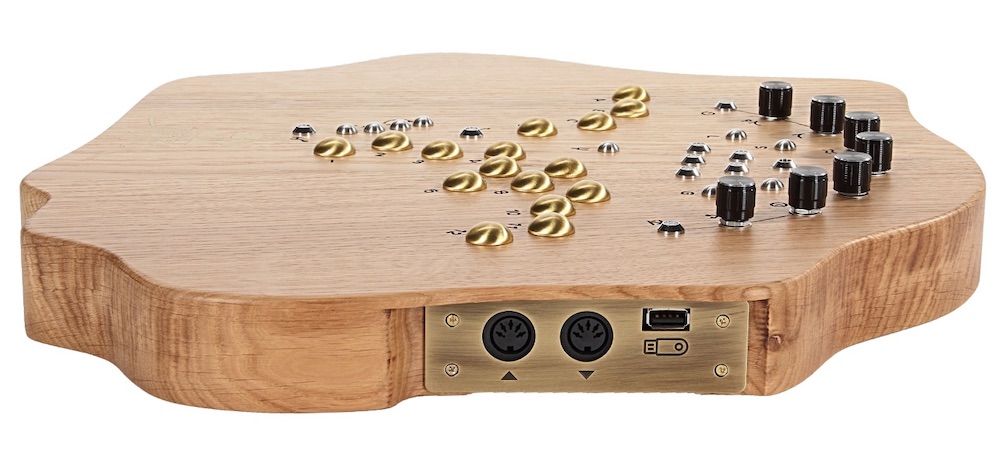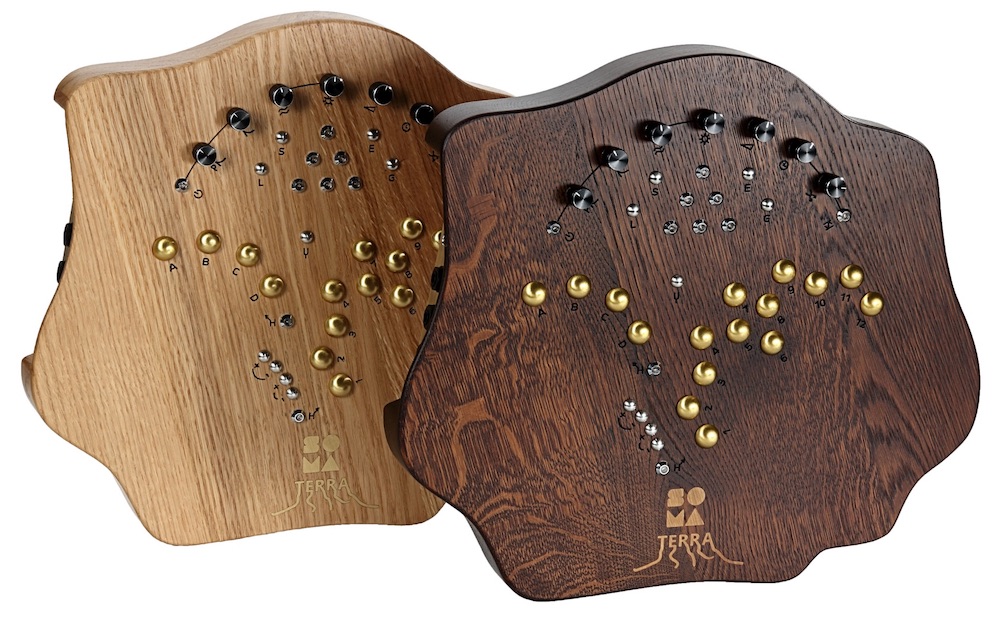The latest experimental offering from Soma presents a unique way of interacting with organic sound. Greg Scarth immerses himself in the Terra philosophy.

Soma Laboratory isn’t a normal synth brand. Soma’s instruments range are always weird and wonderful. Even the more conventional offerings, like the Pulsar-23 drum machine, start from a recognisably familiar basis and add unusual elements like touch-based circuit bending. The Soma Laboratory Terra is a case in point. Here’s a digital synth with analogue elements, all housed in a slab of wood, with a wildly unconventional interface. Wacky? You bet. Inspiring? We’ll see.
Removing the Terra from its box, you’re immediately struck by the visual beauty of this organic unit. The Terra is all based around a slab of wood (light oak in the case of our review unit, but a dark option is also available), adorned with large brass touch sensors and smaller steel buttons, with just just a few conventional rotary knobs around the top curve. The physical specifications of the Terra start off simple and then get unorthodox. To get started, you’ll need to connect the power supply and then either hook up some headphones or a line output. This is where things very quickly veer away from the conventional. The interface for the unit are split into two main regions, with a lower ‘play zone’ and upper ‘control zone’. The control zone is where synth parameters are tweaked, presets loaded, and so on. Down below, the play zone is split into a parametric section (marked A to D) and note section (1-12), with four pitch shifter buttons giving you access to the range of a full piano keyboard.
Most Soma instruments are based on analogue synth circuits, but the Terra is proudly digital at heart. With that said, Soma are keen to point out that the analogue eoutput stage of the Soma is integral to the overall sound of the instrument. A high-quality Burr-Brown DA converter moves the signal into the analogue realm, but more importantly the analogue elements which follow are designed to add a distinctive character to the signal, using discrete components including new-old-stock germanium transistors as part of a class A circuit.

As with most Soma instruments, there are two obvious ways of approaching the Terra: you can dig into the excellent 63-page manual and learn what everything does, or you can simply start touching things and see what happens. In this case, the latter approach reveals an instrument which is almost inexplicably captivating. Your left hand instinctively falls to the ABCD sensors of the parametric keyboard, controlling the timbre of the sound. Your right hand, meanwhile, skips up and down those 12 note sensors, deliberately laid out in a non-linear way which encourages you not to think in terms of conventional piano keyboards or scales. Hold sensors for the parametric and note keyboards allow you to lock settings or notes on at the touch of the steel surround, with a central LED lighting up to indicate that hold is active. It’s hard not to be charmed by the sounds which come from the Terra immediately, playing melodies and chords with the right hand and reaching between the parametric keyboard and the control zone to explore what happens when you tweak the controls and touch the sensors.

Digging deeper into the workings of the Terra, things are charmingly esoteric. The digital synth core of the instrument is deliberately designed for versatility, with 32 different algorithms split into four groups of eight: polyphonic, experimental, bass and solo (the latter two both monophonic). Sonically, it’s a hugely varied selection of sounds; presets are loaded and saved using the triangular array of sensors in the control zone, and flicking through a few quickly reveals the depth on offer. Algorithms range from virtual analogue lushness through to 80s Casiotone bleeps, vocoder-esque voices, electro-acoustic plucks, monophonic bass patches and arpeggiated organs. Individual algorithms respond similarly in a lot of ways, with the main controls for parameters like envelope release times and effects being shared among most, but the behaviour of the ‘sea knob’ (“controlling a synthesis parameter of the Water domain”) and ‘sun knob’ (Light domain) and built-in gyroscope changes for each parameter.

What sets the Terra apart from most other unorthodox instruments is its sense of control. This is an instrument which can get weird and wonderful, microtonal and obtuse all you want, but it’s also one which can be tamed and managed in any musical context. Each note sensor and pitch shifter position can be individually tuned, but you can also just play things safe and stay in harmony with conventionally tuned instruments. It’s this balance which really makes the Terra so much fun to play, allowing you to express yourself with unusual tunings, tease out the most delicate touch-sensitive pitch bends and vibrato, but also sync the LFO to a MIDI or CV clock, lock in to precise arpeggios or go wild with gyroscopic modulation.

If you’re still unsure about the Terra, Soma’s summary of the instrument might help you determine whether it’s for you. The Terra is, they say, “a sanctuary for a natural soul right in the middle of the rumbling plastic world, a ground where you can breathe in and out slowly, and hold on to your roots… [a] dream about a bright future where we will be both technologically advanced and more connected to nature…” There will be some for whom this kind of vaguely hippyish philosophy will be a huge turn-off, and that’s fine – there are plenty of brands who’ll sell you a conventional synth with a generic plastic keyboard – but if you’re willing to embrace the weirdness and come on board with Soma’s ethos, the Terra is as good a starting point as any. The world of synths is all the richer for this kind of esoteric approach.
Greg Scarth
More info/buy